Robin Dupont shares his experience
The heritage of the Sanctuary of Lourdes is made up of a collection of items from the four corners of the world and from different periods. Robin Dupont, who has been working on its conservation since 2001, tells us about his career and his commitment to preserving this historical and artistic treasure.
Hello Robin. Could you tell us about your academic background and your experience at the Sanctuary of Lourdes?
I started at the Sanctuary as a conservation assistant in 2001 and became curator in 2020. My academic background includes a doctorate in art history and archaeology, as well as a master’s degree in literature and ancient history. I also taught art history in Pau for 5 years.
What exactly does your job as curator at the Sanctuary of Lourdes involve?
My job is to look after the Sanctuary’s historical and artistic heritage, which includes objects of worship, liturgical vestments, banners, paintings and sculptures from all over the world.

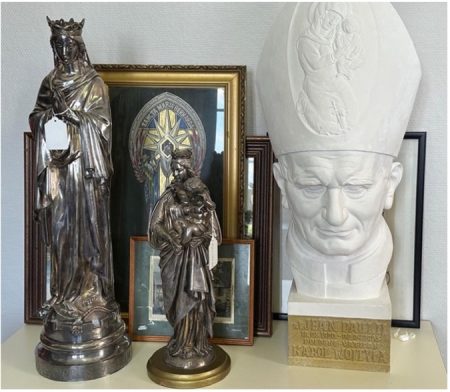

This involves managing the inventory, advising on maintenance and supervising restoration work, often in collaboration with experts such as SOCRA. SOCRA, for example, took care of the Gemmaux in the Basilica of St Pius X, and the statuary and mosaics in the Sanctuary. Restorers of gold and silverware and antique textiles are often harder to find. We carry out some restorations in-house, such as sewing and the conservation of statues.
Outre la restauration, je veille à la mise à disposition du patrimoine pour les cérémonies. Généralement, le service liturgique me fait part de ses besoins, mais je fais aussi des propositions.


How do you assess the value of a collection such as that of the Sanctuary of Lourdes?
We rely on experts in gold and silverware and antique textiles to help us analyse the objects. We also identify the hallmark, which is a mark on the object that identifies the goldsmith and the material. The history of each donation is also researched to establish an insurance value.
Do we have any “gems” in the Sanctuary archives?
Among the best-known “gems” is the rock that the Virgin touched with her foot during the Apparitions. It was removed from the Grotto when the statue of Mary was installed. We also have Commissioner Jacomet’s notebook and letters from Bernadette.
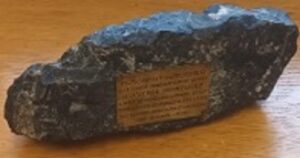

The “treasures” also include the ciborium donated by Charles III of Monaco in 1872 and the so-called “Crown of France”, i.e. of Our Lady of Lourdes, from 1876. Commissioned by Pope Pius IX to adorn the statue of Our Lady of Lourdes, this crown was made by Mellerio known as Meller, a Parisian jeweller renowned for his royal jewellery, rings and religious crowns.
Could you tell us about the history of the Lourdes banners?
The history of the banners began in October 1872, under the episcopacy of Mgr. Pichenot, when all the dioceses of France brought a banner from their parish to Lourdes for the Procession of the Banners. The Immaculate Conception Basilica thus became home to 302 banners, which were hung from the triforia and under the vaults as adornments.
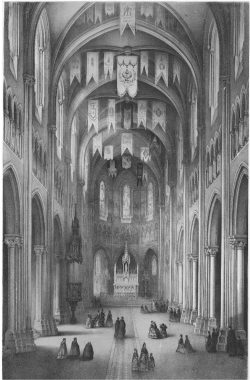
Subsequently, banners poured in from all over the world: Poland, Portugal, Spain, Belgium, Ireland, England, Scotland, Italy, Turkey, the United States, Mexico, China and even further afield. Even today, banners arrive from the four corners of the globe, adding to this unique collection at the Sanctuary of Lourdes. It’s said that there isn’t a Catholic country that doesn’t have its own banner in Lourdes!
In 1946, a second series of banners arrived at the request of Mgr. Choquet, who asked the dioceses to bring in new banners to replace the old ones that had become damaged.
Unfortunately, over time, these banners deteriorated due to the effects of the weather and the smoke from the candles. There was a risk that they would fall and set fire to the basilica, so they were removed.
Today, we keep around 300 banners in the heritage conservation department.


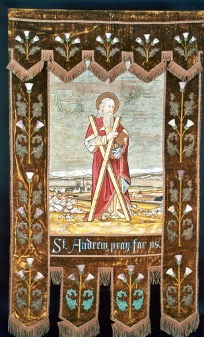



How do you date a banner?
Sometimes, the inscriptions on the banners make it possible to identify their date of origin. We have many banners dating from 1872, the year the first banners were brought to Lourdes. At that time, dioceses could order their banners from the House of Biais couturier, who offered three types of unique shapes.


Banner designs by Biais
The archives keep records of banner donations, making it possible to trace their history. Before the 1940s, the “Journal de la Grotte” and the “Annales” of Lourdes provided information on pilgrimages, often accompanied by descriptions of banners and names of donors.
To catalogue our collections, we use a software programme called “Heritage Index”. The Sanctuary is the main user of this software, which allows us to tailor it to our needs. Each object, like the banners, is catalogued and examined.
What techniques are used to restore and conserve banners?
These are delicate tasks, and many banners are in very poor condition.
Restoration is costly and often practically impossible. Restoring a banner involves removing the damaged parts and replacing them with a new fabric, while preserving as much of the original fabric as possible.
The banners are kept in a room with a controlled temperature. They are placed on metal racks, with a maximum of three or four banners stacked on top of each other. A white cotton or linen cloth is placed between each banner to protect it from damp, and tissue paper is used to prevent the embroideries from catching on each other.
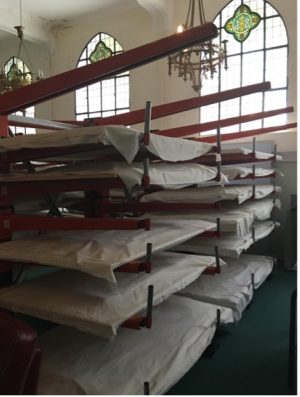
Do you have any current projects relating to the banners collection?
A book on the banners will be available from the Bookshop on 13th August 2024. We’re also lending out the banners more and more: recently, they were used during the International Military Pilgrimage, and were loaned to Tarbes for Corpus Christi. For the national pilgrimage on 15th August, we are making a dozen banners available for use.
What do you like about your job?
I enjoy the diversity of the tasks, from research to the restoration of historic objects. It’s a multidisciplinary job where no two days are the same. What’s more, the richness and history of the heritage of Lourdes is a great source of satisfaction and inspiration.
What are the main challenges?
One difficulty is prioritising different tasks such as inventories, object analysis and hygiene monitoring. At the same time, we have to carry out long-term projects that require great thoroughness. For example, we are currently involved in creating a historical resources centre at the Sanctuary. The aim of this centre is to make the collections accessible to the public and to make it easier to consult archive documents. We also aim to double the storage space for our collections and archives.
Any interesting anecdotes?
I’m sometimes surprised by certain discoveries.
One day, I received a letter in the post containing the rosary of Lisa Cesson, a woman who was miraculously cured in 1912. Her family had found it in a drawer.
In the attic of the Immaculate Conception Basilica, I also discovered a valuable sixteenth-century painting by Michele Tosini, completely blackened by the soot from the candles. This oil on wood by the Florentine artist Michele Tosini depicts Mary, Jesus and the infant John the Baptist. Very few works by this painter exist, and how the painting came to be in the Sanctuary remains a mystery.

If this interview has inspired you, come and take a look at the basilicas, frescoes and statues of the Sanctuary of Lourdes, as well as the banners carried in today’s processions. Some of the Sanctuary’s exhibits are also on display in the Museum of Saint Bernadette.
In this year of processions, we invite you to come to Lourdes with your own banner to take part in this long-standing tradition.






















